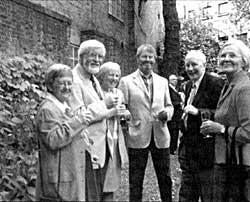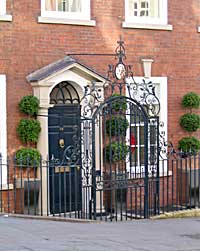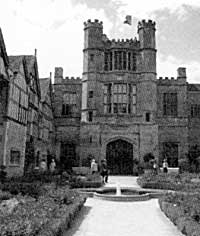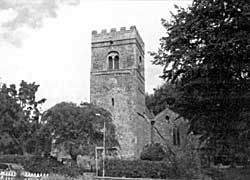Society events and lectures, Summer 2004
 |
SUMMER GARDEN PARTY: Bromley House, Nottingham, 20 June 2004
A new event on the Thoroton calendar: a summer
garden party. Pick the middle of June and what do you get? Well, rain,
of course. So the plans for sitting outside in the garden of Bromley House
had to be amended to standing outside, and having the food inside. Being
British, we coped. Seventy-seven members and guests attended. Music was
provided by Ian Reeve and supporters, and tea was served by Heather Wilkinson
and her helpers. The rain did produce one bonus - Julia Wilson, librarian
at Bromley House, kindly opened the library, and led several tours of the
building. Members were able to see and, if they chose, to have their tea
in the Thoroton Room. Several took away membership applications for this
splendid library set in the heart of Nottingham and yet apparently untouched
by the buzz of the city. Grateful thanks go to Neville Hoskins and his
team of helpers, which included David Hoskins, Peter Reddish, Alan Langton
and others, for making the day such a success. Last but not least, thanks
go to Elizabeth Robinson, who maintains the garden at Bromley House, and
for looking after the tree we planted a couple of years ago.
John
Beckett
REPORTS OF RECENT LECTURES AND EXCURSIONS
 |
Nottingham's Eighteenth-Century Town Houses - 30 May and 27 June
Following on from his lecture on 10 January,
Peter Smith led walks around Nottingham to visit the 18th-century town
houses, with numbers being limited. Peter's eloquent explanations of the
buildings and his ability to maintain his voice meant that on both occasions
he kept up our interest.
Leslie Cram
Note: Newsletter No. 31 drew members' attention
to a series of papers by Peter Smith in the Georgian Group Journal. His
latest addition to the history of Wollaton Hall is a 28-page paper in the
Spring 2004 Journal of the Garden History Society. With the intriguing
title The Sundial Garden and the House-plan mount, two gardens at Wollaton
Hall, Nottinghamshire, by Robert (c1535-1614) and John (?-1634) Smythson,
it explores a little-known aspect of the Willoughbys' activities. In Peter's
usual authorative style, it is well worth looking for - though not every
library has a copy.
Neville Hoskins
 |
Coughton Court - 12 June
Coughton Court is a National Trust property near Alcester in
Warwickshire. It is one of England's finest Tudor houses, and has been
the home of the Throckmorton family since 1409, and houses a fine collection
of furniture and porcelain. The Throckmortons are Roman Catholics, and
there is a particularly interesting exhibition which, while being a testament
to the steadfastness of their faith, graphically illustrates the saga of
the relationship between Protestants and Roman Catholics over the centuries.
The story of the Gunpowder Plot is vividly displayed - as is the account
of the life of Nicholas Owen, master priest hole builder - so fine a craftsman
that some of his work probably still remains to be discovered. The walled
garden, with its herbaceous borders and rose labyrinth, was a great attraction
to our members. After tea at Tutbury we moved on to Melbourne church, a
mini-cathedral, with its magnificent Norman interiors. Built by the Bishops
of Carlisle when the Scots border raiding parties came too close for comfort,
its massive Norman pillars and arches seem oddly out of place in this quiet
little Derbyshire town. The day ended with a magnificent display by the
Red Arrows at nearby Donington Park. We are grateful to leader and guide,
Dr Ann Hope.
Keith Goodman
 |
North Nottinghamshire Churches - 3 July
Five more North Nottinghamshire churches were visited on July 3rd - those of Gamston, North Leverton, South Leverton, Laneham and Rampton. Each brought its own fascination; each was impressive. The broad high tower of St Peter's Gamston drew us to our first church. Fifteenth-century clerestory windows ensure that the first impression is one of light. We appreciated being able to handle the beautiful Gamston chalice made in 1569. Next was St. Martin's church, North Leverton, which incorporates a range of styles-the south doorway, being magnificent late Norman. The church of All Saints, South Leverton, dates back to the 12th century [see picture above]. Graceful arcades are thirteenth-century originals. By contrast, beautiful quilted pictures honour the recent millennium. This is a much-loved building kept in tip-top condition.
Our next church, St Peter's, Laneham has a
porch built in 1932 housing a Norman south doorway. Its ancient original
door hangs on the adjacent wall. In the chancel herringbone masonry indicates
the Saxon-Norman transition. Of note were the solid oak pews, the Markham
memorial and the 14th century stained glass. Finally, the church of Rampton
All Saints is essentially medieval in origin, and the wall type piscina
is thought to be one of the earliest in the county. Five solid, ancient
buildings - architecturally interesting, but telling us also of the unknown
thousands of worshippers whose faithful love sustained these churches over
centuries. Our excursion leaders Jean Nicholson and Michael Jackson did
us proud. We were also very well fed, thanks to Jean and her team. It was
a stimulating day.
Barbara Maddison
Report of visit to Brewhouse Yard
10 June Brewhouse
Yard, or - to give it the official title - the Museum of Nottingham Life,
is known to many local people, but what happens behind the scenes, notably
in the adjoining Waterworks Building which is part of the complex? Members
who booked early - apologies to those who were disappointed - found the
answer to this question rather more complex than they imagined. Under
the careful guidance of Suella Postles and Ann Inckster, we were introduced
to a range of resources seldom seen by the public, including
artefacts from Africa and other parts of Europe. We learned about how
the museum service classifies everything it owns, and about some of the
hidden treasures which are only occasionally on show to the public. We also
learned about Mr Campion, the motorbike man who led Thoroton archaeological
work in the 1930s - does anyone remember him? - and about the massive backlog
bequeathed to the service by the last city
archaeologist. If and when it gets written up, the material will provide
many of the missing links in our understanding of medieval Nottingham. And,
finally, Suella and Ann are always on the lookout for volunteers - so if
you are interested and able to offer them any help with their work, please
give Suella a ring on 0115-9153602.
John Beckett